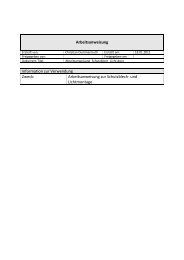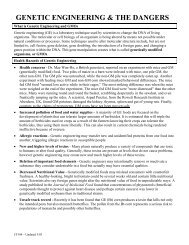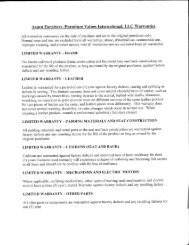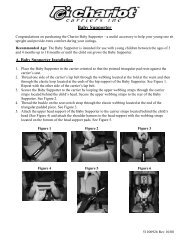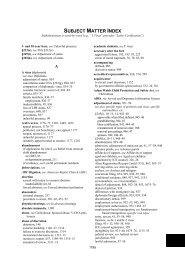Create successful ePaper yourself
Turn your PDF publications into a flip-book with our unique Google optimized e-Paper software.
Gay Interest, Noir & Erotica<br />
Robert Mapplethorpe:<br />
Almodóvar’s Gaze<br />
LA fábrICA/GALeríA eLvIrA GonzáLez<br />
Text by siri hustvedt.<br />
taking as its point of departure the meeting of two<br />
artists at a tumultuous moment in the 1980s, Almodovar’s<br />
Gaze explores how the photographic and filmmaking<br />
lens can fruitfully overlap. american<br />
photographer robert mapplethorpe (1946–1989) and<br />
Spanish filmmaker pedro almodóvar (born 1949) first<br />
met in madrid in 1984, when the photographer was<br />
there on a visit occasioned by his first exhibition in<br />
the city. mapplethorpe was already an accomplished<br />
artist, 38 years old and sure of himself and his sensibility.<br />
pedro almodóvar was a well-known filmmaker<br />
in the Spanish underground, and the best-known international<br />
representative of the madrid–based countercultural<br />
movida movement that arose after<br />
general Franco’s death in 1975. mapplethorpe and<br />
almodóvar had gone out partying in madrid, which<br />
at the time was particularly receptive to young artists<br />
closer to the underground than to the establishment.<br />
the later impact that mapplethorpe’s retrospective<br />
exhibition at the Whitney museum of american art<br />
had on almodóvar in 1987 was tremendous. this intimate<br />
arrangement of mapplethorpe’s seductive and<br />
powerful images was carefully selected by almodóvar<br />
from over 1,700 of mapplethorpe’s photographs.<br />
978-84-15303-58-9<br />
Clth, 9 x 11 in. / 70 pgs / color.<br />
U.S. $55.00 CDn $55.00<br />
September/photography/gay & Lesbian<br />
Alvin Baltrop:<br />
Dreams Into Glass<br />
ConTeMPorArY ArTs MuseuM housTon<br />
edited and with text by valerie Cassel oliver. Introduction<br />
by douglas Crimp. foreword by bill Arning.<br />
Dreams into Glass accompanies the first major museum<br />
exhibition of african-american photographer<br />
alvin Baltrop (1948–2004), whose career unfolded in<br />
the late 1960s amid a period of turbulent social and<br />
political upheaval. Following a stint in the navy,<br />
Baltrop returned to new York in the 1970s and<br />
immersed himself in the city’s decaying landscape,<br />
documenting a post-industrial wasteland of vacant<br />
manufacturing buildings that included the piers<br />
located along the Hudson river in lower manhattan.<br />
It was here that Baltrop captured his most iconic<br />
images of nocturnal danger and despair alongside<br />
intimate and voyeuristic portraits of the homeless,<br />
teenage runaways, prostitutes and clandestine sexual<br />
encounters. During this period, Baltrop captured<br />
gordon matta-Clark’s monumental piece “Day’s<br />
end” and the work of graffiti artist, tava, now lost to<br />
history. this survey features over three decades of<br />
vintage and reprinted photographs as well as archival<br />
material—from Baltrop’s intimate portraits of navy<br />
friends and other enlisted men to his poetic body<br />
abstractions and street photography to the documentation<br />
of an era of gay sexual abandon between the<br />
Stonewall riots and the aIDS pandemic.<br />
978-1-933619-39-2<br />
pbk, 10 x 8.5 in. / 60 pgs / 10 color / 30 b&w.<br />
U.S. $14.95 CDn $14.95<br />
august/photography/african american art &<br />
Culture/gay & Lesbian<br />
exHIBItIon SCHeDULe<br />
Houston, tx: Contemporary arts museum Houston<br />
07/20/12–10/21/12<br />
Mark Morrisroe:<br />
Mark Dirt<br />
PAPer ChAse Press<br />
Introduction by stuart Comer. Text by Lia<br />
Gangitano, ramsey McPhillips.<br />
the photographs of mark morrisroe (1959–1989) are<br />
steeped in fragility, both as material objects scored<br />
and pockmarked by the vicissitudes of time, and as<br />
forlorn commemorations of brief moments in all too<br />
brief lives. In this sense, the photographs are also objects<br />
of ephemera, of a piece with morrisroe’s equally<br />
fragile magazines, collages and drawings, which this<br />
volume compiles for the first time. Containing much<br />
previously unpublished work, Mark Dirt includes<br />
spreads from morrisroe’s punk zine Dirt (“he sort of<br />
invented the Boston punk scene,” Jack pierson later<br />
recalled of his former lover), as well as correspondence<br />
and notes by the artist, sketches and even his<br />
last will and testament. all of these documents have<br />
been assembled by morrisroe’s longtime partner<br />
ramsey mcphillips, and represent the most complete<br />
survey of the artist’s non-photographic works.<br />
978-0-9852044-1-9<br />
Flexi, 8 x 11 in. / 40 pgs / 30 color.<br />
U.S. $24.00 CDn $24.00<br />
July/photography/gay & Lesbian<br />
exHIBItIon SCHeDULe<br />
new York: participant Inc., Fall 2012<br />
Also Available:<br />
Mark Morrisroe<br />
9783037641217<br />
flexi, u.s. $65.00 Cdn $65.00<br />
JrP|ringier<br />
Nobuyoshi Araki:<br />
It Was Once a Paradise<br />
refLex edITIons<br />
Text by Marcel feil, robbert roos.<br />
arguably Japan’s greatest living photographer and<br />
the author of over 425 books to date, nobuyoshi araki<br />
(born 1940) is internationally known for his erotic images<br />
of tied-up, beautiful nude women. It Was Once a<br />
Paradise presents araki’s most recent photographic<br />
series, 40 diptychs that offer a meditation on sex and<br />
grief. each diptych couples a new color photograph of<br />
a semi-nude woman in bondage with a black-andwhite<br />
still life from his personal diary, a somber<br />
image taken on his tokyo balcony: the site of his former<br />
private paradise haunted by his deceased wife<br />
Yoko and his cat Chiro. nostalgic ruins contrast with<br />
erotic hope, forming a contrast that is echoed in the<br />
packaging of the book, which has been designed to<br />
be read in either direction, and comes with a choice of<br />
two different dust jackets.<br />
978-90-71848-12-4<br />
Hbk, 9.75 x 13.75 in. / 100 pgs / 41 color / 46 tritone /<br />
Limited edition of 750 copies.<br />
U.S. $110.00 CDn $110.00<br />
July/photography/asian art & Culture<br />
Also Available:<br />
Araki: Love and death<br />
9788836617371<br />
Pbk, u.s. $65.00 Cdn $65.00<br />
silvana editoriale<br />
Morton Bartlett:<br />
Secret Universe III<br />
wALTher könIG, köLn<br />
edited and with foreword by udo kittelmann,<br />
Claudia dichter. Text by Lee kogan.<br />
When the freelance photographer and graphic<br />
designer morton Bartlett (1909–1992) died at the<br />
age of 83, his relatives found 15 chests among his<br />
possessions. each chest contained a half-life-size<br />
doll and its accessories: 12 girls and three boys,<br />
a wardrobe of hand-sewn clothes, black-and-white<br />
photographs of each doll as well as countless studies<br />
and archival materials. Bartlett began designing<br />
these dolls in the mid-1930s, studying anatomy books<br />
and histories of costume, and learning to sew and<br />
mold with clay to make them as true to life as<br />
possible. each doll entailed a huge amount of labor,<br />
taking up to a year to complete; Bartlett created<br />
costumes and wigs for each one and then staged<br />
them in lifelike scenarios and photographed them,<br />
documenting a family he had never had and creating<br />
a body of work that would remain unexhibited during<br />
his lifetime. the third installment in the Bahnhof<br />
museum’s series on outsider artists, this volume<br />
examines Bartlett’s extraordinary lifelong obsession.<br />
978-3-86335-162-5<br />
pbk, 8 x 9.75 in. / 112 pgs / 36 color.<br />
U.S. $39.95 CDn $39.95<br />
august/art<br />
PhoToGrAPhY hIGhLIGhTs<br />
Watabe Yukichi:<br />
A Criminal Investigation<br />
edITIons xAvIer bArrAL/Le bAL<br />
Text by Titus boeder.<br />
on 13 January 1958, the grotesquely disfigured body<br />
of a man was discovered near Lake Sembako in<br />
Japan. two investigators from tokyo came to help<br />
the local police in resolving what at first appeared to<br />
be a banal case, but which soon proved to be something<br />
more complicated. For the first time, a photographer<br />
was authorized to accompany the police to<br />
document the investigation. press photographer<br />
Watabe Yukichi (1924–1993) followed the inspectors<br />
as they questioned witnesses (workers in a tannery<br />
factory, local police officers) and pounded the streets<br />
of the most insalubrious neighborhoods in tokyo—<br />
its bars, bridges, alleyways and hospitals—in search<br />
of the killer. Like the haunted film stills of a newly<br />
discovered noir classic, Watabe’s images record<br />
much more than simply a police investigation, and<br />
reveal a tokyo of the 1950s in a way that has rarely<br />
been depicted.<br />
978-2-9151-7382-6<br />
Clth, 8.25 x 11.5 in. / 200 pgs / 70 duotone.<br />
U.S. $85.00 CDn $85.00<br />
June/photography/asian art & Culture<br />
90 artBooK | D.a.p. 1.800.338.2665 orders@dapinc.com artBooK.Com 91





